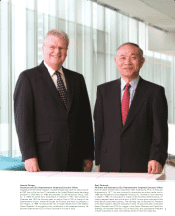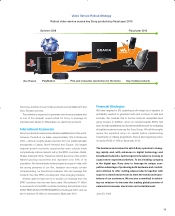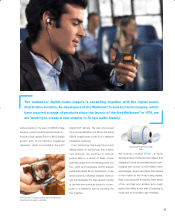Sony 2008 Annual Report Download - page 19
Download and view the complete annual report
Please find page 19 of the 2008 Sony annual report below. You can navigate through the pages in the report by either clicking on the pages listed below, or by using the keyword search tool below to find specific information within the annual report.
17
What was your initial impression of the OLED panel?
When I fi rst saw the images displayed by the prototype, I was absolutely astounded. The image quality was
inspiring, and unlike anything I had ever seen before. Even if we started with an 11-inch model, I just knew
we had to show this technology to the world. As a television engineer, I remember being unable to contain
my excitement.
What are the advantages of the OLED as a next-generation display?
The XEL-1 has attracted a great deal of attention because of its sleek profi le—about 3mm at the thinnest
point—but what I think is truly impressive is the display’s expressiveness and its unparalleled ability to repro-
duce black. OLEDs reproduce subtle gradations of black more accurately than any other display. What this
means, for example, is that they convey beautifully the gleam of a black sofa in a dark room or the luster of
a piano. Another unique attribute of OLEDs is the ability to deliver high peak brightness, which ensures faith-
ful reproduction of the glittering surface of water, the sheen of metal or the explosive fl are of fi reworks. This
new level of picture quality has taken the lead over existing display technologies.
What were the most challenging aspects of development?
Development efforts were focused on optimizing the color gamut, contrast and other features, as well as
on developing a display driver that would accurately reproduce black. It was also important to establish a
stable mass production capability that would ensure uniform quality and otherwise draw out and leverage
the exceptional panel quality. Initially yield was a major issue, but the collective efforts of those involved in
the production processes have led to steady improvements. Our success in commercializing this product
was propelled by the coordinated efforts of all the teams involved: device, set design and development,
production and marketing.
What efforts are being made to produce larger panels?
Huge crowds gathered to see the OLED prototypes we exhibited recently at trade shows in Japan and the
United States. Both times, I was impressed by the level of anticipation regarding this latest Sony innovation.
It was clear that if we were to continue bringing the superb image quality of OLED to market, we would have
to fi nd a way to make the panels bigger. We must proceed with R&D that will enable us to realize necessary
innovations and move us closer to the commercialization of larger panels.
What are some of the notable features of the XEL-1’s design?
I knew I wanted to design a television that would immediately inspire in users the same feelings of surprise
and excitement as I had when I fi rst saw the incredibly thin OLED panel. I sought to create a simple and
defi nitive form that reinforced the impression of sleekness. In its simplest form, the television would have a
base and a central arm supporting the panel. However, as long as the arm was centered, the result would
be a familiar silhouette similar to any other monitor or television, not the innovative look I was after. Realizing
this, I made the bold decision to move the arm to one side. By using an offset aluminum arm, I sought to
make the ultrathin panel appear to be fl oating on air.
What facets of the design process did you fi nd particularly diffi cult?
The most diffi cult challenge was to create a design that was defi nitive, so that no matter how small the
picture, and no matter who or from where the TV is seen, anyone would immediately recognize it as a Sony
OLED television. Of course, I also sought to design a set that would accentuate the outstanding image qual-
ity and one that would stand on its own as a work of art even when switched off, no matter what angle you
look at it from. OLED panels have a particular sheen when they are off that is quite unlike LCD panels. We
chose glossy black for the main body color, which integrates the screen, bezel and base nicely and helps
the set blend into the surrounding decor as light refl ects off it.
Hiroaki Yokota
Product Designer,
Creative Center,
Sony Corporation
Designer of the world’s first
OLED television, Hiroaki Yokota
sought to develop an iconic
design by creating a new form
factor and distinctive style.
Ken Kikuchi
Engineer, E Products &
Business Development Dept,
TV Business Group,
Sony Corporation
Ken Kikuchi has been involved
in Sony’s OLED project since
its inauguration in the summer
of 2006. In his capacity as an
engineer in charge of panels for
televisions, Ken brought his
considerable experience in
CRT and LCD televisions to
bear in helping to realize the
commercialization of XEL-1.
important. In August 2007, S-LCD
Corporation (S-LCD), our joint venture with
Samsung Electronics Co., Ltd., began
production of eighth-generation amorphous
thin-fi lm transistor (TFT) LCD panels. The
new production line has a monthly capacity
of 50,000 panels, one of the highest in the
industry for eighth-generation panels.
Additionally, S-LCD has bolstered the
monthly production capacity of its seventh-
generation LCD panel line, and is currently
producing 120,000 panels monthly.
In addition, in February 2008 we announced
plans to establish a joint venture with Sharp
Corporation to produce large LCD panels. In
fi scal year 2009, the joint venture is expected
to begin production at a panel plant that will
use the industry’s first 10th-generation
17
08SonyE_P14_27_0802.indd 1708SonyE_P14_27_0802.indd 17 08.8.7 2:18:37 PM08.8.7 2:18:37 PM
























